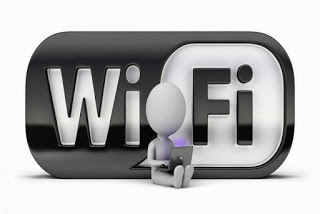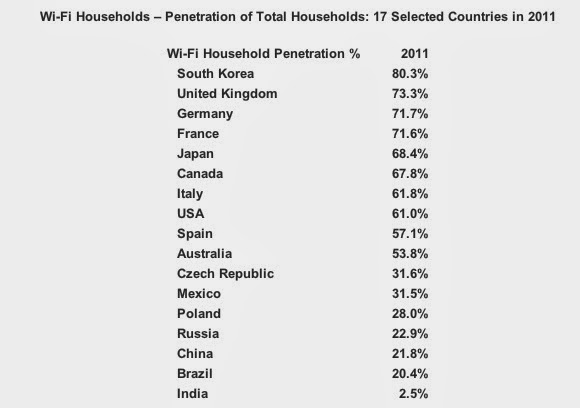Global public wifi hotspot numbers are set to grow from 1.3 million in 2011, to 5.8 million by 2015, marking a 350 per cent increase, according to research published by the Wireless Broadband Alliance (WBA), and compiled by Informa.
In foreign countries like the U.K, U.S, Germany, South Korea France, Japan etc, The technology is pervasive, partly because it’s relatively easy to use and inexpensive to deploy.
In the U.S., 61% of all households currently have WiFi networks installed at home. According to data from Strategy Analytics, this means the U.S. is ahead of countries like Spain (57.1%), Mexico (31.5%) and India (2.5%). At the same time, though, this only puts the U.S. somewhere in the lower half of WiFi adoption among developed nations. In countries like South Korea (80.3%), the UK (73.3%) and Canada (67.8%), significantly more households currently have WiFi networks installed. – (www.techcrunch.com 2012)
If these Countries Already have these Large percentage of Wi-Fi Household Penetration as at the end 2011, You can imagine the increment by the end of 2014. whereas We are way Still back, even lower than India which have 2.5% as at then.
In 2012, A study by WIK and Aegis, funded by the European Commission, highlights the importance of Wi-Fi for connecting EU citizens to the Internet. In 2012 71% of all wireless data traffic that was delivered to smartphones and tablets in the EU was delivered via Wi-Fi. Mobile data traffic is estimated to grow at 66% annually for the period 2012-2017, but at the same time almost 80% of all traffic to mobile devices is predicted to come over Wi-Fi. – (www.ec.europa.eu 2013)
According to a survey conducted by Wakefield Research in 2010 on behalf of the Wi-Fi Alliance, 64 percent of U.S. respondents and 89 percent of Chinese respondent said it would be nearly impossible to maintain relationships with many friends without Wi-Fi; a further 44 percent of American respondents and 82 percent of Chinese respondents said the same applies to family relationships. The survey was based on information provided by 1,000 U.S. millennials (respondents ages 17 to 29) and 400 millennials in China, Japan and Korea. Two thirds of U.S. respondents and four fifths of those in China said they now spend more time on Wi-Fi than watching telly. Almost 70 percent of respondents spend more than four hours on Wi-Fi each day. – (www.wifialliance.com 2010)
The importance of Wi-Fi cannot be over emphasized with the below statistics as Proof!!
U.S Statistics:
- Over 1 billion connected devices, worth approximately $580 billion, shipped in 2012, a 30% increase over 2011. (IDC)
- Wi-Fi equipment shipments grew by 17% in the first quarter of 2013, and the latest version 802.11ac (which supports video streaming) has barely entered the market. (ABI Research)
- During the second quarter of 2013, the amount of data consumed over Wi-Fi was four times the amount consumed over cellular data networks (on average, 2197 Mbps vs. 473 Mbps per month). (WeFI)
- The cable industry is building a national Wi-Fi network called Cable WiFi that will allow roaming for cable broadband subscribers. So far, they have collectively built 150K Wi-Fi hotspots in the U.S.
- 63% of U.S. adults use the Internet wirelessly on a smartphone, tablet, laptop, or e-reader (Pew Research Center)
UK Statistics
- UK households have an average of 4.6 devices connected to a home WiFi network at any given time (TP-Link)
- 61% of U.K. Internet users would be less reliant on their PC if WiFi were more widely available (Kinetic)
- Mobile devices account for 47% of U.K. Wi-Fi usage (JiWire 2012)
- 79% of week 1 sales of Sony’s Playstation Vita in the UK were for the Wi-Fi version (UKIE 2012)
Wi-Fi usage is increasing in many part of the world as it is a way to reduce mobile phone data bills.
The Big Question is: When will Nigeria Embrace the Use of Wi-Fi?





